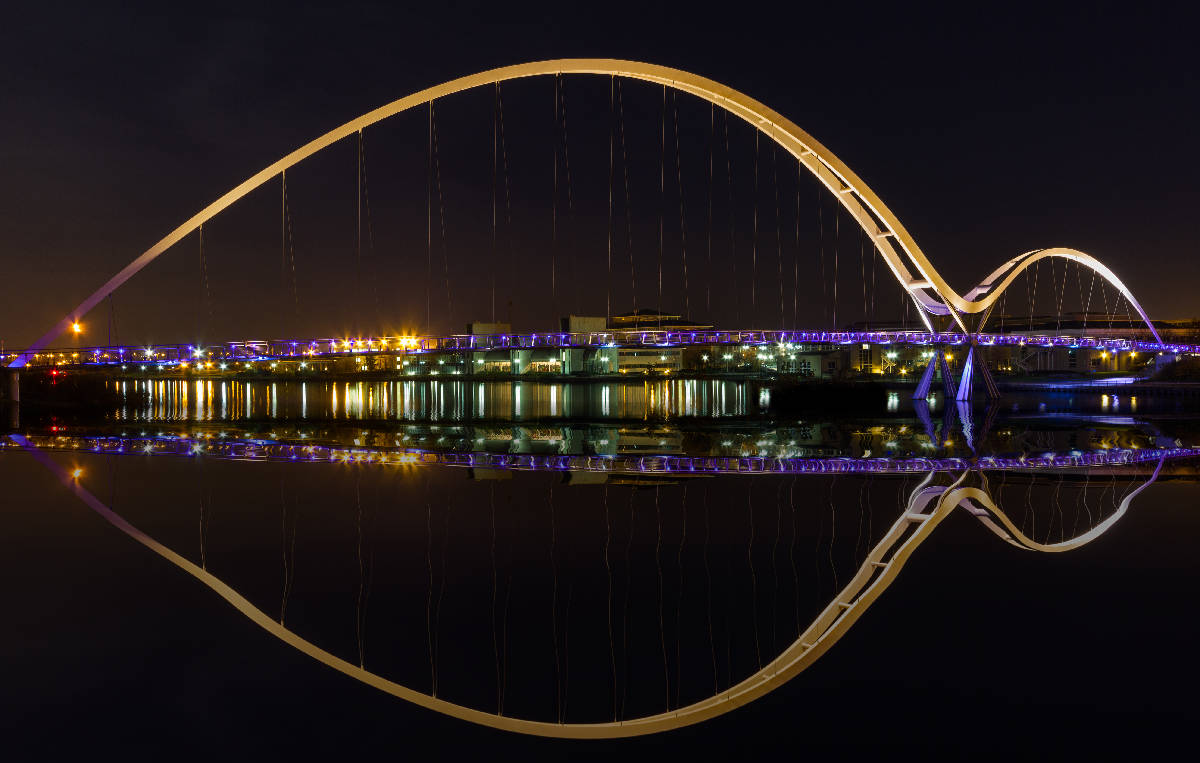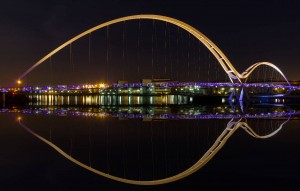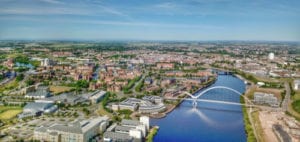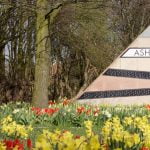
Stockton or Stockton-on-Tees to give it it’s full title is situated in the North East of England, 250 miles (400km) north of London and 38 miles (61 km) south of Newcastle, close to the North Sea, on the north bank of the River Tees. Stockton is particularly known for its heavy industrial heritage and as being one end of the famed Stockton to Darlington Railway. It was the world’s very first railway line. Today it is also home to the infinity Bridge which as you can see below is absolutely stunning when lit up at night.

Image: Bahadir Yeniceri/Shutterstock.com
A Fleeting History of Stockton-on-Tees
Stockton has its origins as a 5th or 6th-century Anglo-Saxon settlement, built on raised ground, close to the north bank of the River Tees.
The manor of Stockton was first created around 1138. The district was eventually purchased by Bishop Pudsey of Durham in 1189. Around 1201, the village of Stockton was granted borough status by King John. In 1235, a Chapel of Ease was built in Stockton’s Parish of Norton. In 1310, Stockton was granted its market charter by Bishop Beck of Durham. During the late 14th century, the fortified manor house of Stockton Castle became one of the Bishop of Durham’s residences.
Medieval Stockton began to develop into a busy albeit small port, mostly exporting wool and importing wine. At this time, Stockton-on-Tees only had a population of around 1,000, which remained static for a great number of years. In the 15th century, shipbuilding began to emerge in the town as an industry.
In 1644, the Scots captured Stockton Castle, occupying it for around two years. It was eventually demolished on the order of Oliver Cromwell when the English Civil War ended in 1651. Unfortunately, there are no known accurate depictions of the castle which have survived.
In the 17th and 18th centuries, Stockton began to prosper as never before. What had been small scale industries, such as brick, sail and rope making, began to ramp up production to an industrial scale. Stockton became the main port of trade for County Durham, the North Riding of Yorkshire and Westmorland. Shipbuilding also began to prosper on a much larger scale.
In 1735, the town hall, traditionally known as ‘Town House’, was built in High Street. It still serves its original purpose as Council Chambers.
In 1771, a multiple stone arch bridge was built over the River Tees, superseding the existing Bishop’s Ferry operation, giving the town much greater connectivity.
By the end of the 18th century, the onset of the Industrial Revolution had changed the character of Stockton from a small, quiet market town into a flourishing centre for heavy industry.
19th Century Stockton
In 1822, Stockton witnessed an event that was about to change the world. Heralding the dawn of the railway age, on the 13th May, the first part of the track of the Stockton to Darlington Railway was laid near St John’s Crossing, on Bridge Road. On 27th September 1825, Locomotion No.1, manned by renowned inventor and railway engineer, George Stephenson, made its historic inaugural journey from Etherley to Stockton, to mark the official opening of the world’s first railway line. The railway was obviously a great boost for Stockton, making it much easier to bring coal to the town for industrial use. Paradoxically, the port went into decline as business began to move downriver to Middlesbrough.
In 1827, local chemist John Walker invented the friction match in his shop at 59 High Street. The first sale of the matches was recorded in his sales-book on 7 April 1827, to a Mr. Hixon, a solicitor in the town. Unfortunately, Mr Walker did not obtain a patent for his invention, so received neither the recognition nor wealth he should have been due for his invention.
The town grew rapidly as the Industrial Revolution progressed, especially with the discovery of iron ore at Eston Hills in 1837. Ironmaking and engineering quickly became established in the town. Within 20 years, new iron and steelworks stretched along the south bank of the River Tees. Between 1851 and 1901, the huge influx of migrant workers saw the towns population swell from 10,000 to over 50,000. By 1881, the Stockton area was amongst the largest producers of iron and steel in the world.
Stockton Gets a Hospital
The first hospital in Stockton opened in 1862, and in 1877, the town got its first public library. In 1881, steam-powered trams began running on the town’s streets. In 1897, the steam trams were replaced by electric trams, which themselves were replaced by buses in 1931.
In the 1920s and 30’s large scale slum clearance took place in Stockton to make way for the first council houses being built. However, during this period, Stockton, along with the rest of the north-east, and other areas dominated by heavy industries was profoundly hit by the impact of the Great Depression. In 1933, during the grip of the ‘depression’ a notorious clash
In the mid-20th century, Stockton was still heavily reliant on heavy industry and engineering.
The Modern Era

Image: myks/Shutterstock.com
Today Stockton’s High Street is reputedly the widest road through any town centre in the country. Most of the town centre buildings have a Georgian and late medieval influence. There are a good number of listed buildings within the town centre. Shops predominantly have narrow frontages and the medieval burgage plots are particularly evident around the marketplace and its side streets. However, much of Stockton town centre was refurbished in the 1960’s, with the Castlegate Shopping Centre opening in 1973.
Contrary to the town’s development, by the 1980’s, Stockton’s heavy manufacturing industry had severely contracted, along with many jobs in the sector.
The service sector and light industry have grown in the place of heavy industry, and today they are the town’s mainstay employers. Opening in 1988, the development of Teesdale Business Park on the south bank of the River Tees has created a complex with a great area of commercial space. In particular, many large service providers have located their call centres and offices in the space.
In 1995, after four years in the building, the Tees Barrage was put into service, permanently holding the upstream river waters at the level of an average high tide. The river has now been utilised for water sports and associated recreational activity with the area.
In 1996, after a number of government reorganisations, full independence and responsibility for all local services was restored to Stockton, and thus it’s status as a unitary authority. In 1999, the ARC Theatre & Arts Centre was built, which is a multi-purpose arts centre, embracing cinema, theatre, dance and music.
A Few More Stockton Facts
In 1993, an incident that was dubbed the ‘Battle of Stockton’ took place. A rally organised in the town by the British Union of Fascists was thwarted by around 2,000 local anti-fascist sympathisers. Running battles broke out in the streets between opposing sides, and while nobody was killed, but there were serious injuries.
The population of Stockton on Tees at the 2011 census, was recorded as 124,474.
In 1992, Teesside Polytechnic became the University of Teesside, one of the UK’s first new universities following that year’s Further Education Act. The University has obviously given the town more kudos and has gone from strength to strength since its opening.
Getting To Stockton-on-Tees
If you are driving to Stockton-on-Tees, then there are two arterial roads that serve the town, the A66 and the A19. The trans-Pennine A66, connects the town with nearby Middlesbrough to the east, and with Darlington and Cumbria, to the west. The A19 runs north to south, connecting the town with Sunderland and Newcastle northwards, and with York and most of the rest of Yorkshire to the south.
Stockton-on-Tees railway station serves the town, but more regular and distant services are operated from the nearby Thornaby railway station. Thornaby has better connectivity than Stockton, being located on the Durham Coast Line. It’s operated by Northern Rail, who provide all the station’s passenger services. Thornaby station is situated to the east of the River Tees on the opposite bank to Stockton.
All trains on the Tees Valley Line and Durham Coast Line call at the station, giving it hourly services northbound to Sunderland and Newcastle. and 30 minutes westbound trains to Darlington and eastbound to Saltburn. TransPennine Express services to York, Leeds and Manchester Airport also stop here every hour. All eastbound trains call (or terminate) at Middlesbrough.
Between them, Arriva North East Limited and Stagecoach on Teesside provide the majority of scheduled bus services within the Borough of Stockton. The remaining services are provided by six smaller operators which are; Compass Royston Travel Ltd, Leven Valley Coaches, Hutchinson’s, Scarlet Band, Tees Valley Coaches and Go (North-East). Take a look at the Connect Tees Valley website for the bus timetables in the Stockton area.
Durham Tees Valley Airport (formerly Teesside Airport) is located several miles west of the town. The airport offers domestic and international flights, the latter being particularly to EU countries. Newcastle International Airport (NCL) offers an alternative destination from which to arrive/leave the area. The connecting journey between NCL and Stockton is about 1 hour by taxi, and 2 hours by train.
Places to see!
Preston Hall Museum and Park
Preston Hall is set in 100 acres of attractive parkland, overlooking the River Tees. The museum has displays of art, armour and social history. You can discover what life was like in the home as far back as 1825. And, stroll back in time along a typical local street of the 1890s, complete with traditional craftspeople. The Park also has a range of other attractions which include; exotic birdlife, a wildfowl pond, and many riverside and woodland paths. You can also visit Butterfly World, take a ride on the Tees Small Gauge Railway or boat on the river. There’s a safe surface play area for children with a cafe.
Things to do In Stockton
There are lots of things to do in and around Stockton Borough, especially linked to water sports and other sporting activities.
Castlegate Quay Watersports Centre (CQWC)
At CQWC you can learn how to paddle kayaks/canoes or how to sail. As well as kayaking or sailing, there’s also bell boating or even powerboating! You could also opt for the multi-activity day which lets you try a bit of everything. They can also cater for more experienced users. It’s open 7 days a week, 9 am to 9 pm in summer, and 9 am to 5 pm in winter.
Billingham Forum
Billingham Forum is a huge leisure complex. The forum offers an excellent range of facilities for the whole family including a swimming pool, a gym, fitness classes, squash courts, theatre and more. If you’re into ice-skating then the Forum is also likely to be the place for you. It’s rated the North East’s number one ice rink!
Stockton Accommodation
Indicative prices for the commonly available types of accommodation, in and around Stockton on Tees, for two people sharing, are as follows:
Luxury Hotel: £80 – £120 (2 people sharing)
Standard Hotel: £40 – £80 (2 people sharing)
Apartment: £100 – £150 (usually sleeping about 4 people)
Try Our Stockton Quiz
Quiz Maker – powered by Riddle





